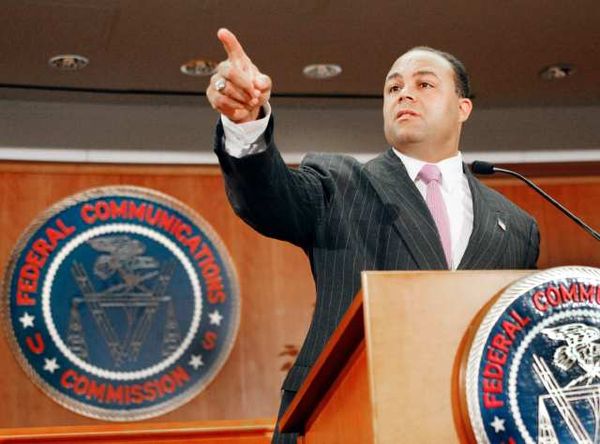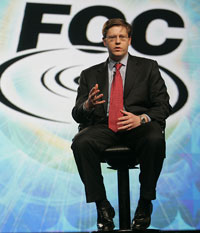Four years ago, on July 7, 2011, the United States Third Circuit Court of Appeals handed down a second “remand” to the Federal Communications Commission’s attempt to weaken its media ownership rules. When a court remands an action by a government agency, it is telling the agency that the decision is somehow wrong, often procedurally wrong, and needs to be revised. The challenge to the FCC was initiated by the Prometheus Radio Project.
The controversy began in 2003, when, in the Prometheus Project’s own words: “the FCC, under Chairman Michael Powell, sought to dismantle the remaining protections against media consolidation. Many large companies wanted media ownership rules abolished, allowing them to buy up unlimited media properties and monopolize local markets. Prometheus organized against these changes and commented to the FCC. Then, when the FCC ignored the millions of anti-consolidation comments, we sued the FCC in federal court.”
Christopher Terry’s essay below marks a crucial anniversary in a case famously known as Prometheus versus FCC. Terry teaches Media Law and Policy in the Department of Journalism, Advertising and Media Studies at the University of Wisconsin-Milwaukee. He has 15 years experience as a producer in commercial radio. His doctoral dissertation examined more than 1,000 FCC media ownership decisions between 1996-2010. “I thought we might take the opportunity of this anniversary to discuss how radio got so bad,” he wrote to us. – Editor
July 7, 2015
On February 8th, 1996, President Bill Clinton signed into the law the 1996 Telecommunications Act. Provisions within the Telecommunications Act implemented significant changes the legal, policy and social dynamics of media ownership. Although these changes could be felt across the media spectrum, the radio industry was fundamentally changed by the FCC’s implementation of the legislation.
In terms of legal changes, the Telecommunications Act implemented specific limits on media ownership, mandated by Congress, rather than limits created through rulemaking by the FCC. This change was significant, as prior to 1996, the FCC had determined the limits on media ownership and made decisions on media cross ownership prohibitions through developed rulemaking proceedings. These legal changes also resulted in a significant change in media ownership policy. While the FCC had been slowly raising the limits on media ownership, the changes brought about through rulemaking proceedings had been much smaller in scale. And the scale of the changes to the top end limits on media ownership, including the move to allow the creation of large numbers of commonly owned and operated radio stations at the market level, literally changed the radio business from a local to a national one.
The issue of empirical evidence (or rather the lack of it) in the FCC’s rulemaking process dealing with the limits on ownership of media outlets became a multi-prong problem for the agency. Even setting aside the usual administrative agency requirements for evidence to support rational decisions made when implementing policy, embedded within the 1996 Telecommunications Act was §202(h) which requires the agency to remove or modify rules that are no longer necessary to promote competition or in the public interest. Faced with this mandate, and the requirement to review the existing rules every four years, the Commission has found itself in a serious rulemaking quandary, and one in which policy decisions have suffered significant setback when rulemaking processes have come under judicial review.
Part of this problem stems from the Commission’s attempts to regulate media for three policy objectives, Competition, Localism and Diversity, simultaneously. Favoring the first through the implementation of structural limits on numerical broadcast station ownership, while paying lip service to the second through a seemingly endless rulemaking proceeding, in a vain effort to ensure the third which the FCC repeatedly claims to be the most important, the Commission has struggled to find evidence to support the decisions it has made regarding the media ownership rules, most notably during the release of new regulations in June of 2003. After proposing the Diversity Index, a new system for calculating concentration of media ownership, a diverse coalition of citizen groups ranging from the Sierra Club to the National Rifle Association spoke out against the new media ownership decision, and as nearly a million comments came into the FCC, the Commission faced judicial review of the new policy proposal in the Third Circuit Court of Appeals in Prometheus Radio Project v FCC.
Upholding parts, but remanding large sections of the FCC’s decision in 2003 to the Commission for further review and clarification, the majority in the Third Circuit encouraged the Commission to generate some evidence to support future rulemaking decisions regarding media ownership regulations.
Given the weight of evidence standard that applies in the legal review of administrative rulemaking, the deference typically given to an administrative agency’s expertise by the courts, and the lack of evidence in the form of a review of the effects of the implementation of its structural regulatory scheme, the Prometheus remand in 2004 and second remand issued by the Third Circuit in Prometheus II in 2011 has effectively cut-off any changes to the policy.
Unfortunately for the FCC, the agency’s media ownership policy has become a double-barreled combination of more of the same and evidence which undermines the last 19 plus years of policy implementation. Unfortunately for the rest of us, the FCC’s implementation of media ownership policy, has been, remains, and will continue to be an important democratic issue. The relationship between control of media outlets and the sources of and the diversity of information that citizens have access to is an important one to understand, even in the age of the internet. Broadcasting still plays an important central role in the media use of every day Americans. The use of broadcast media remains at high levels. Even in the face of the digital communications revolution, a large quantity of the informational content on the web is simply repackaged and redistributed from existing media, including “the dinosaurs” of newspapers, radio and broadcast television.
The FCC has failed through a continued reluctance to engage in any sort of meaningful policy evaluation that would provide a measure of viewpoint diversity available within the modern media environment. This failure has been created out a series of interrelated problems. While failing to do any sort of meaningful evaluation of its media ownership policy and going so far as to ignore evidence which demonstrated the policy implementation was having the absolute opposite effect of the intent of the policy, the FCC justified a massive first wave of consolidation in media ownership using theoretical benefits, such as economy of scale, without logically applying the effects of the change, such as the massive reductions in staff and content sharing, to viewpoint diversity. In fact, the FCC championed the benefits of economy of scale in media mergers, until such time as the mergers grew large enough that the control of advertising markets became an issue. As this new challenge arose, the FCC changed the criteria by which it judged mergers, until such a point that the agency was examining mergers that gave the top two competitors in a media market control of up to 99.5% of advertising in that market. With no more room to use advertising markets as a control mechanism, the agency again changed its approach, stating that numerical limits were the best way to ensure viewpoint diversity. And in what might be described as the ultimately craven move by the FCC, the agency justified this third change in approach by recycling nearly forgotten rhetoric about protecting the public interest in ensuring access to diverse and antagonistic viewpoints.
The FCC retains a longstanding belief that each individual owner in a media market will provide one viewpoint, and that competition, both internal (from commonly owned stations) and external (from competitors) will result in an increase in content diversity which meets the stated policy goal of a diversity of viewpoints. As commercial entities, media outlets generate income by selling audiences to advertisers, therefore, external competition limits a station’s audience in situations where competing media organizations provide similar or identical formats. When competing media outlets are providing similar programming, and thus splitting the potential audience for that programming choice between them, theoretically an economic incentive is created to provide alternative programming options to competitors. This incentive to create new programming options will therefore result in content diversity.
If external competition between media organizations theoretically produces content diversity, what about the internal competition between commonly owned media outlets? The theory of a relationship between internal competition and diversity rely on Peter Steiner’s 1952 proposition that a monopoly firm in media could provide more diversity than competing firms. The FCC has adopted this theory as part of the support for its continued reliance on a structural regulatory scheme, arguing that as more media outlets are consolidated into common ownership, an economic incentive is created for a media organization to provide a more diverse set of programming, rather than to provide multiple programming formats that compete for audience with other commonly owned stations.
Competition for audience then, according to theory, creates content diversity through economic incentive, as desirable programming content will be produced by competitors seeking to generate audiences. An audience makes choices, and by keeping marketplace mechanisms in place, you provide the freedom for these consumers to “shop” for the content they want.
Unfortunately for the FCC, among the critics of its structural regulation policies are the federal courts. The primary reason for these legal setbacks has been the Commission’s inability to produce rational empirical evidence supporting licensing and ownership decisions.
In June, 2003, in response to the requirement of a quadrennial review of the media ownership rules, the Commission, without a period of public comment or review, released a revised set of rules that relaxed media ownership limits. At the heart of this order, which allowed substantial additional concentration of media ownership, was the FCC’s new Diversity Index (DI). The Commission’s stated goal was to assure that at least six competitors, newspapers, radio, television and internet sites would exist in each market.
Following a large public response against the new ownership limits, a legal challenge to the order occurred in Prometheus Radio Project v FCC in 2004. The majority took a dim view of the FCC’s new Diversity Index and the relaxed ownership limits the methodology could mathematically justify. As the Commission had failed to provide any evidence to support its decision-making, the court remanded to policy to the FCC. In terms of radio, the majority cited two studies in the docket which demonstrated a 34% in reduction in owners and concrete examples of consolidated radio groups eliminating local news production, to support the majority opinion to retain the existing limits was not supported by the analysis in the docket.
The remand in the first Prometheus Decision remains the primary obstacle of the FCC’s media ownership policy. The Prometheus decision made clear that in order for the Commission to modify its regulations in any significant way, whether in favor on increasing concentration or some types of rollbacks, the FCC must to generate evidence that at least rationally supports the agency’s rulemaking decision.
After the remand was issued, the FCC retreated to lick its wounds. A new FCC chairman, Kevin Martin was appointed in March of 2005, and the media ownership process was set aside until June 21st, 2006 when the FCC began the first required quadrennial reviews under section 202(h) of the Telecommunications Act.
As the proceeding unfolded during the following months, a report was leaked to California Senator Barbara Boxer “indirectly from someone within the FCC who believed the information should be made public.” The report, was launched under the previous Chairman, and now industry lobbyist, Michael Powell’s tenure, after he tasked FCC Media Bureau staff to develop evidence on localism in broadcasting. Notably, the study demonstrated that the local ownership of television stations added almost five and half minutes of news to broadcasts including more than three minutes of “on-location” (i.e. local) news and conclusion that was in direct opposition to the FCC contention in 2003 that “commonly owned television stations are more likely to carry local news than other stations.” After the Senate hearing, news reports also surfaced that the Commission had ordered all copies of the draft study destroyed.
Five days later, a second unreleased draft study, which had been generated as part of the 2002 Review, also surfaced. This study, titled Review of the Radio Industry, contained evidence that was even more damning of the policy implementation than the television localism study. Examining the effects of consolidation on the radio industry between 1996 and March of 2003, the report reached five major conclusions, all of which would have been problematic for the FCC’s decision making in 2003. First, despite a nearly 6% increase in the number of radio stations overall, the number of owners had decreased by 35% and change brought about almost entirely by mergers between existing owners. Second, the largest group owner in 1996 had 65 radio stations which meant that the consolidation of ownership had been even more significant than the 35% reduction suggested. In just seven years, the top two companies, Clear Channel and Cumulus Media, had come to own more than 1,200 and just over 250 respectively. Third, at the local level, the report marked a downward trend in the number of owners in Arbitron markets. Fourth, in terms of advertising competition, the data demonstrated that the top firm in each market controlled an average of 46% of the advertising, and that the top two firms controlled an average of 76% of the advertising market. The report concluded that this level of control was at least partially responsible for an 87 percent increase in ad rates, despite falling ratings numbers. Finally, in terms of the effect of consolidation on the format diversity available, the study suggested that while the numbers of formats had remained largely steady overall, in the larger markets, there was actually a slight reduction in the number of formats being offered.
Each of the findings in these two “lost” studies should have provided the FCC the evidence necessary to reach the absolutely opposite conclusions than it had reached during the 2002 Review. While the localism finding is logical, the assessment of the effects of consolidation on the radio industry are damning of the policy decisions being made at the Commission during the rapid years of radio consolidation 1996-2003.
Not surprisingly, facing the tough evidence and rationale obligations of the Prometheus Remand and the uncovering of evidence which demonstrated that the last ten years of policy decisions were having the opposite effect of their intent, on November 13, 2007, Chairman Martin released a proposed change to only one rule, a partial repeal of the longstanding prohibition on Newspaper-Broadcast Cross Ownership.
After a questionable process that included the circulation of two different versions of the order less than 12 hours before a vote was taken in December of 2007, the rule change was included in an order in February, and a month later, the FCC released one additional media ownership rule developed in a separate proceeding, which was designed, at least nominally, to help increase ownership of media outlets by minorities and women.
No longer allowed to favor minority applicants directly, the agency relied on the Small Business Administration, and created a class of applicants called “eligible entities.” The proposal adopted financial standards, created by the Small Business Administration (SBA), based on gross sales revenue for a radio or television company.
These decisions, like the ones from 2003, were also challenged, and then reviewed by the Third Circuit Court of Appeals panel, under the provisions remand in the first Prometheus case. In July of 2011, the Circuit again remanded the agency decisions again citing procedural and evidence problems with the FCC’s actions. The elements of the judicial review in Prometheus II were very reflective of the issues raised in the decision from Prometheus I. The majority in both cases was critical of the procedure undertaken, the rationales provided, the policy decision reached, and the evidence used to support those decisions.
The majority was extremely critical of the agency’s failure in 2007 to meet the requirements of the earlier remand on the ownership of stations by women and minorities that was issued in the first Prometheus decision. Suggesting that the agency had “in large part punted” on the issue, the ruling imposes a mandate that the remand be addressed before the 2010 Quadrennial Review was completed.
The second Prometheus decision, much like the earlier Prometheus case, is illustrative, in a crystal clear fashion, of the FCC’s ongoing problematic situation with the collection and development of evidence. As the agency continues to struggle with this issue and then using the evidence to demonstrate a reasoned analysis for its decision making, it is important to summarize the process which occurred from 1996 to 2010. The agency, pursuant to the Telecommunications Act, launched into a proceeding without collecting any evidence. Then faced with multiple reviews of its decision making, the agency has failed to generate evidence which would support its decision making, ignored evidence which demonstrated that the policy implementation was failing to meet the stated objectives, and has proposed policies that even reviewing courts suggest “defy logic.” The agency’s decision making on media ownership has endured four remands on judicial review, or more specifically, one for each of the reviews in which changes were proposed. While faulty administrative procedure and poor policy design have each played a role in the failures of the FCC’s decision-making on media ownership, the evidence issues, specifically the lack of evidence, cannot be ignored.
In basic terms, the reality is that it does not matter what measurement method you apply, every existing evaluation of the FCC’s current policy implementation, including the two the agency temporarily “lost,” has demonstrated that the agency’s stated policy goals are not being achieved, and in many cases are being undermined, by the ownership policy decisions the Commission has made since the 1996 Telecommunications Act was handed down. No empirical results exist that support the theory that either internal or external competition is increasing the quantity or diversity of informational programming.
So what does all this jibber-jabber mean? As we celebrate the anniversary of the Prometheus Radio Project, remember, radio is in the state it is in today because our regulators chose to make it that way, and still, in the face of overwhelming evidence, continue to refuse to admit they were wrong.
Dr. Christopher Terry is a Lecturer of Media Law and Policy in the Department of Journalism, Advertising and Media Studies at the University of Wisconsin-Milwaukee who spent more than 15 years as a producer in commercial radio. His dissertation examined more than 1000 FCC media ownership decisions between 1996-2010, and he has published research on media diversity, political advertising and of course, media ownership policy.
Contact him via email at crterry@uwm.edu or on twitter @christopherterr






